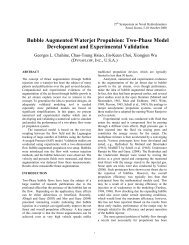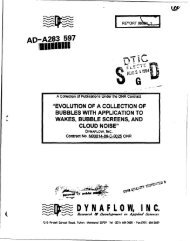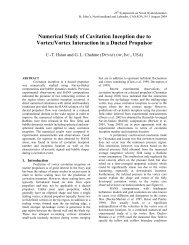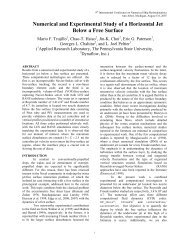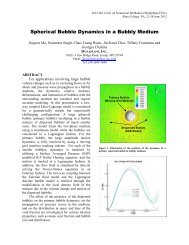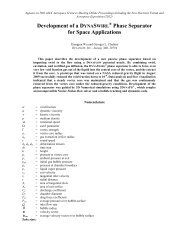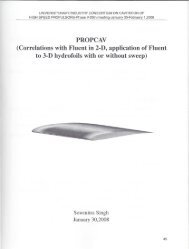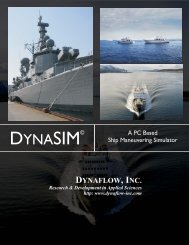ABS Acoustic Bubble Spectrometer - Dynaflow, Inc.
ABS Acoustic Bubble Spectrometer - Dynaflow, Inc.
ABS Acoustic Bubble Spectrometer - Dynaflow, Inc.
Create successful ePaper yourself
Turn your PDF publications into a flip-book with our unique Google optimized e-Paper software.
<strong>ABS</strong><br />
<strong>Acoustic</strong><br />
<strong>Bubble</strong><br />
<strong>Spectrometer</strong><br />
®<br />
Measurement of <strong>Bubble</strong> Size, <strong>Bubble</strong> Number & Void Fraction<br />
®<br />
DYNAFLOW, INC.<br />
Research & Development<br />
in Applied Sciences<br />
DYNAFLOW, INC.
123456789012345678901234567890121234567890123456789012345<br />
123456789012345678901234567890121234567890123456789012345<br />
123456789012345678901234567890121234567890123456789012345<br />
123456789012345678901234567890121234567890123456789012345<br />
123456789012345678901234567890121234567890123456789012345<br />
123456789012345678901234567890121234567890123456789012345<br />
The <strong>ABS</strong> Advantage<br />
123456789012345678901234567890121234567890123456789012345<br />
123456789012345678901234567890121234567890123456789012345<br />
• Very sensitive to bubbles<br />
• Optically transparent liquid or<br />
containers are not required<br />
• Distinguishes bubbles from particles<br />
• Built on a PC Windows platform with a<br />
user-friendly graphical interface<br />
• Measurements are easily and rapidly<br />
conducted<br />
• Validated by comparison with<br />
microphotography<br />
• Near real-time measurement<br />
Applications<br />
123456789012345678901234567890121234567890123456789012345<br />
• Cost effective<br />
• User-friendly system<br />
Maritime – hydrodynamics, propulsor performance,<br />
cavitation, power plants, turbomachinery, pumps<br />
Biomedical – blood transfusions, artificial heart valve, bubbles in tissue<br />
and blood, decompression sickness<br />
Space – effects of microgravity on multiphase fluids, reduced pressure<br />
effects<br />
Oceanography – atmosphere / ocean interface studies, air entrainment,<br />
oxygenation, sound transmission, background noise<br />
Multiphase Flow – valves, pumps, propellers, fluid machinery,<br />
industrial & chemical processes, specialty fluids, measurement of<br />
aeration bubbles, boiling<br />
Education / Research – fluid dynamic & cavitation studies, bubble nuclei<br />
in water tunnels<br />
Environmental – categorizing fish by size, monitoring sewage treatment,<br />
mixing<br />
<strong>ABS</strong> 2
12345678901234<br />
12345678901234<br />
12345678901234<br />
12345678901234<br />
12345678901234<br />
12345678901234<br />
12345678901234<br />
12345678901234<br />
12345678901234<br />
12345678901234<br />
12345678901234<br />
12345678901234<br />
<strong>Acoustic</strong><br />
<strong>Bubble</strong><br />
<strong>Spectrometer</strong><br />
®©<br />
12345678901234<br />
12345678901234<br />
12345678901234<br />
Background<br />
The <strong>ABS</strong> <strong>Acoustic</strong> <strong>Bubble</strong> <strong>Spectrometer</strong> ®© is an instrument<br />
developed by DYNAFLOW, INC. to measure bubble size distributions<br />
and void fraction in gas/liquid mixtures and flows. Not only does the<br />
<strong>ABS</strong> measure the total “void fraction” (volume fraction of the gas<br />
phase in the liquid ), it also measures the distribution of the sizes of<br />
the bubbles. This difficult-to-measure characteristic proves invaluable<br />
in numerous areas. For example the top ten meters of the sea contain<br />
many bubbles that greatly affect acoustic properties by scattering<br />
signals and creating noise. Knowledge of the bubble size distributionis<br />
also important when modeling chemical or biological processes. The<br />
<strong>ABS</strong> is also useful in the development of processes that mix a gas in a<br />
liquid such as waste treatment and the design of aeration systems.<br />
Another application area where the <strong>ABS</strong> proves invaluable is<br />
engineered systems that might experience cavitation.<br />
Cavitation is the formation of vaporous and gaseous filled bubbles or<br />
“cavities” in a liquid, typically due to a sudden change in pressure.<br />
This occurs, for example, along the flow path through a pump or over<br />
a propeller blade. Cavitation can have a dramatic effect on both the<br />
performance and life of such devices. In particular, cavitation<br />
significantly affects the performance and operation of propellers,<br />
hydrofoils and pumps. The collapse of cavitation bubbles cause both<br />
substantial physical damage and considerable noise. The distribution of<br />
bubble nuclei strongly influences the propensity for cavitation. This is<br />
particularly important if one wants to experimentally scale a device<br />
subject to cavitation since it is necessary to properly control and account<br />
for the existing bubble nuclei distribution in the liquid.<br />
Measuring bubble distribution, visually or optically, is painstaking or<br />
impossible when dealing with a large system and a non transparent<br />
medium. Moreover, it becomes increasingly difficult to distinguish<br />
small particulates from small bubbles. <strong>Bubble</strong>s, however, are more<br />
sensitive to acoustic waves than particulates, hence the <strong>ABS</strong> can readily<br />
pick out small bubbles in a liquid. The <strong>ABS</strong> also does not require<br />
optically transparent liquids or containing structures.<br />
3 DYNAFLOW, INC.
How the <strong>ABS</strong> System Works<br />
The <strong>ABS</strong> is built around a PC Windows platform and includes high-speed<br />
cards for signal generation and data acquisition. This high speed operation<br />
is required because the signal bursts are very short in order to detect<br />
very small bubbles. Additionally, since the system determines any changes<br />
in the speed of sound due to the presence of bubbles, true<br />
simultaneous sampling is mandatory, especially when the distance between<br />
the two hydrophones is small.<br />
The Raw Signals Display which shows the transmitted and received data.<br />
Two hydrophones or transducers are used, one to transmit and the other<br />
to receive a series of short monochromatic bursts of varying frequencies.<br />
From these readings, the attenuation and phase speed in the bubbly liquid<br />
are determined as a function of the frequency. The data from these<br />
signals are processed and analyzed with the copyrighted software algorithms<br />
developed by DYNAFLOW. These algorithms employ specialized techniques<br />
to solve the mathematically ill-posed inverse problems, and thus obtain the<br />
bubble size distribution and void fraction.<br />
Sketch of the <strong>ABS</strong> <strong>Acoustic</strong> <strong>Bubble</strong> <strong>Spectrometer</strong> ®© Operational System<br />
In-line <strong>ABS</strong> Measurements<br />
<strong>ABS</strong> 4
The Principle of Operation<br />
The <strong>ABS</strong> <strong>Acoustic</strong> <strong>Bubble</strong> <strong>Spectrometer</strong> ®© exploits the fact that bubbles<br />
strongly affect acoustic wave propagation. <strong>Bubble</strong> size distribution<br />
measurements are based on a dispersion relation for sound wave<br />
propagation through a bubbly liquid. <strong>Bubble</strong>s in the liquid have an effect on<br />
the strength of the signal that reaches the receiver, as well as on the speed<br />
at which the signal travels between the emitter and receiver. <strong>Bubble</strong>s of a<br />
given size have a resonant frequency where effects are the strongest, but<br />
will affect signals of all frequencies. For each burst, the system measures<br />
the changes in the speed of sound and the signal amplitude. With more<br />
bubbles, the speed of sound and the signal’s amplitude decrease further.<br />
<strong>ABS</strong><br />
<strong>Acoustic</strong><br />
<strong>Bubble</strong><br />
<strong>Spectrometer</strong><br />
®©<br />
A multiphase fluid model for sound propagation through bubbly liquids<br />
is combined with a model for the bubble oscillations, including various<br />
damping modes. The combined model relates the attenuation and phase<br />
velocity of a sound wave to the bubble population or size distribution.<br />
These relations produce two ill-posed Fredholm integral equations that<br />
require special treatment for their solution, particularly in the presence of<br />
noise. Novel algorithms developed by DYNAFLOW are used to accurately<br />
solve these equations using a constrained optimization technique that<br />
imposes a number of physical constraints on the solution.<br />
http://www.dynaflow-inc.com/Products/<strong>ABS</strong>/<strong>ABS</strong>.htm<br />
5 DYNAFLOW, INC.
Operation of the <strong>ABS</strong><br />
User Input<br />
Measurements are easily and rapidly conducted with the aid of a userfriendly<br />
Graphical User Interface. All physical, experimental, and analytical<br />
parameters are input by the user via dialog boxes initially loaded<br />
with default values. Both raw and processed experimental data can be<br />
saved to disk for future use. The signals and results are displayed<br />
graphically by the interface in real time and can also be stored or<br />
printed. The measurement can be started either by clicking on an icon<br />
displayed on the screen or through use of an external trigger signal to<br />
The Dialog Box to enter Signal Parameters<br />
synchronize with a desired event.<br />
The Dialog Box to Enter Physical Parameters<br />
A “pure liquid” provides a background reference state. This “no bubble”<br />
reference state is used in calculating the bubble size distribution from<br />
data “with bubbles”. This reference state data set is obtained by<br />
conducting an experiment in the absence of bubbles under conditions and<br />
settings otherwise identical to those which will be employed in determining<br />
the desired bubble size distribution.<br />
Displayed Results<br />
Results from the analysis of the experimental data appear on the screen<br />
in easy to read displays in the form of plots.<br />
Sound Speed Ratio (u=c/co) versus frequency<br />
Attenuation Ratio (v) versus frequency<br />
<strong>Bubble</strong> Size Distribution as the number of bubbles per cubic<br />
centimeter versus bubble radius in microns<br />
Void fraction contributions vs bubble size<br />
Screen shot of the <strong>ABS</strong> output graphical user interface showing the sound speed ratio u, the<br />
attenuation ratio v and the resulting bubble size distribution.<br />
<strong>ABS</strong><br />
6
Validation<br />
The bubble distributions obtained from the <strong>ABS</strong> <strong>Acoustic</strong> <strong>Bubble</strong><br />
<strong>Spectrometer</strong>® have been validated by comparison with microphotography.<br />
<strong>Bubble</strong> populations were generated using electrolysis and air<br />
injection through porous tubes. The bubble population obtained using<br />
the <strong>ABS</strong> compared very favorably with the results of the microphotography.<br />
Number per cm 3<br />
12<br />
<strong>ABS</strong> 30% max air<br />
10<br />
Photo 30% max air<br />
8<br />
<strong>ABS</strong> 60% max air<br />
Photo 60% max air<br />
6<br />
4<br />
2<br />
0<br />
0 20 40 60 80 100 120 140 160<br />
-2<br />
Bubblr Radius, µm<br />
Air/Water<br />
Mixing<br />
Tank<br />
Sensitivity of the bubble size distribution measurements to the amount of injected air<br />
Bubbly<br />
Flow<br />
Transducers<br />
Air Injection<br />
Microporous<br />
Tube<br />
Water Shear<br />
Number per cm 3<br />
7<br />
6<br />
5<br />
4<br />
3<br />
2<br />
<strong>ABS</strong> Average 6 tests<br />
Photos Average 132 frames<br />
Test<br />
Section<br />
Pump<br />
<strong>Bubble</strong> Size<br />
Distribution<br />
Display<br />
1<br />
0<br />
14 25 45 64 84 104 124 144 163<br />
<strong>Bubble</strong> Radius, µm<br />
Comparison between <strong>ABS</strong> measurements and micro video photography<br />
<strong>ABS</strong><br />
Main Characteristics<br />
Data Acquisition 5 MS/s. , 10 MS/s.<br />
Transducers used :<br />
Size range 1cm 10 cm<br />
Frequency range 2 khz 300 khz<br />
Typical <strong>Bubble</strong> sizes 2μm 500 μm<br />
Note that the software and the principle of operation are not dependent<br />
on the ranges of instrument operation, which are controlled by the data<br />
acquisition card and the hydrophones used. These can be upgraded<br />
Total Void fraction of 2x10<br />
without needing to modify the basic bubble size determination software. -3<br />
Comparison of the bubble density distribution between high speed video measurements<br />
and <strong>ABS</strong> <strong>Acoustic</strong> <strong>Bubble</strong> <strong>Spectrometer</strong> ®©<br />
7 DYNAFLOW, INC.
Generation II<br />
<strong>ABS</strong> <strong>Acoustic</strong> <strong>Bubble</strong> <strong>Spectrometer</strong> ®©<br />
Generation II <strong>ABS</strong> <strong>Acoustic</strong> <strong>Bubble</strong> <strong>Spectrometer</strong>®© exploits new aquisition cards and PC hardware<br />
developments and significantly improves the <strong>ABS</strong> performance. It is built on a Windows XP based<br />
PC (either a desktop or a laptop) with high-speed cards for signal generation and data acquisition. It<br />
now boasts a data acquisition speed up to 10 MS/s for each channel, provides stable signal output<br />
over a wide frequency range, and is being developed to support more than one set of hydrophones<br />
to improve bubble size measurement range.<br />
Base System <strong>Inc</strong>ludes the following:<br />
• High-speed data aqusition card for signal generation and data acquisition (data sampling<br />
rate 5 MS/s per channel).<br />
• A desktop computer, cables and adapters.<br />
• First year support and upgrades of the DYNAFLOW<br />
proprietary <strong>ABS</strong> Software to drive the<br />
transducers/hydrophones, and to analyze the data.<br />
• Two 1/2in square transducers with 15 ft. cables<br />
Upgrades for the system are as follows:<br />
• Laptop PC<br />
• Higher Data acquisition speed - 10 MS/s per channel<br />
• Different size transducers<br />
• Amplifier<br />
• Multi-set hydrophones support<br />
Generation II Specs<br />
Base System<br />
Desktop Pentium IV (CPU Only), Windows XP<br />
5 MHz Data Acquisition Card<br />
1/2 inch Transducers (2)<br />
First Year Software Support and Upgrades<br />
Upgrade<br />
Total Void fraction of 2x10<br />
Comparison of the bubble density distribution<br />
between high speed video measurements and<br />
<strong>ABS</strong> <strong>Acoustic</strong> <strong>Bubble</strong> <strong>Spectrometer</strong>®©<br />
-3<br />
10 MHz Data Acquisition Card<br />
Notebook PC w/Extension unit for PCI<br />
64 Bit Dual Core Processor
Side by Side Comparison of the Generation I and Generation II systems<br />
Requirements Generation II Generation I<br />
Generation II<br />
Advantages<br />
Sampling rate<br />
5 MS/s or 10 MS/s for<br />
each channel<br />
Up to 2.2 MS/s shared<br />
by two channels<br />
More accurate results<br />
especially for high<br />
frequency signals<br />
Resolution 12-bit 12-bit N/A<br />
Signal Generation-<br />
Voltage output<br />
20V peak-peak. Almost<br />
constant voltage output<br />
over the frequency range<br />
16V peak-peak, voltage<br />
output decreases with<br />
frequency<br />
Better and almost<br />
constant signal output<br />
Signal Generation-<br />
Frequency limit<br />
Capable of emitting and<br />
receiving signals up to<br />
450 kHz<br />
Capable of emitting and<br />
receiving signals up to<br />
200 kHz<br />
Higher frequency signals<br />
Enable detection of<br />
smaller bubbles<br />
Requirements Generation II Generation I<br />
Generation II<br />
Advantages<br />
Computer<br />
Any computer with one<br />
spare PCI slots<br />
Computer must have 2<br />
spare ISA and 1 spare<br />
PCI slots<br />
Can use virtually any<br />
Computer<br />
Operating System<br />
Windows NT/XP<br />
compatible<br />
Windows NT<br />
Compatible with updated<br />
Windows XP<br />
Portable System<br />
Any laptop computer<br />
with a PCMCIA slot<br />
Special order lunch box<br />
PC is required<br />
Portable system can use<br />
virtually any laptop<br />
D YNAFLOW,I<br />
NC.<br />
10621-J Iron Bridge Road, Jessup, MD 20794-9381 USA<br />
Phone: (301) 604-3688, Fax: (301) 604-3689<br />
E-mail: info@dynaflow-inc.com URL: http://www.dynaflow-inc.com
DYNAFLOW’s capabilities include :<br />
Cavitation<br />
Multiphase Flows<br />
<strong>Acoustic</strong>s<br />
Flow Visualization<br />
Underwater Explosions<br />
Computational Fluid Dynamics<br />
Software Development<br />
Water Jet Technology<br />
Computed Tomography<br />
Fluid-Structure Interaction<br />
Liquid & Air Filtration<br />
Materials Erosion<br />
Oxidation<br />
DYNAFLOW, INC.<br />
DYNAFLOW, INC.<br />
10621-J Iron Bridge Road<br />
Jessup, MD 20794<br />
TEL: (301) 604-3688<br />
FAX: (301) 604-3689<br />
E-mail: info@dynaflow-inc.com<br />
URL: http://www.dynaflow-inc.com



